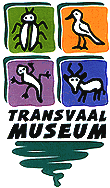
Transvaal Museum
Paul Kruger Street
SOUTH AFRICA
Tel:
Fax:
Display Halls
General Information & Fees
Map
Genesis I: Hall of Life
This is the first of the main halls upstairs, depicting the history of
life on earth. It is designed in such a way that it gives a time-based history of
the development of animal life on earth, from its earliest beginnings to its present diversity. There are models of primitive animals such as Protozoa, hydra and sea-anemones as well as tape-worms, nematodes and earth worms, molluscs, insects and spiders. There are displays of sharks and bony fish, including the coelacanth that was caught in 1938 off East London in the Eastern Cape. The Genesis I Hall ends with displays on amphibians and reptiles.

Genesis II: Mammal Hall
This hall is all about mammals and their evolutionary history. Included are displays of mammal-like reptiles and dinosaurs. The world famous mammal-like reptiles lived in southern Africa about 270 to 170 million years ago. Displays of early hominids (Australopithecus) and Mrs Ples can also be seen in here. Just before you leave the Mammal Hall, there is a display of the toothed and baleen whales to which dolphins also belong. All these models are 1/10 of their actual size.



Austin Roberts Bird Hall
This hall was named after Dr Austin Roberts who worked as an ornithologist at the Transvaal Museum from 1910 to 1948. On the mezzanine floor there is
a display of nearly 870 of southern Africa's birds, numerically arranged according to Roberts' Birds of Southern Africa to commemorate his work.


GeoScience Museum
This museum exhibits a comprehensive collection of materials, precious and
semi-precious stones. Although linked to the Transvaal Museum, these displays are provided by the Council of GeoScience.